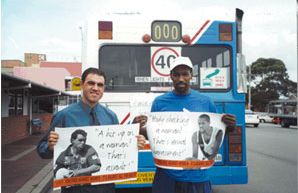A substantial part of formative research consists in finding out as much as possible about the target audiences. Especially in campaigns aiming at changing individuals’ behaviour, one should have a clear idea of the targets’ attitudes and behaviour before starting to design the campaign. Precise knowledge about the audience informs design of messages, techniques and tools that resonate with the audience. Campaign evaluations show that “the most successful [public awareness campaigns] are those that seek to understand their target audience and engage with its members to develop content.” (WHO 2009: 3)
Methods of research
Common methods in formative primary research on audiences are surveys, focus group discussions, in-depth interviews and group discussions – see Monitoring and Evaluation in this module for guidance. Creative methods, such as role play and games can be particularly effective to gather qualitative data, especially with children or where language barriers exist.
Example: It’s Against All the Rules (South Wales, Australia)
The state-wide public education campaign ‘Violence Against Women: It’s Against All the Rules’ was a project of the Violence Against Women Specialist Unit and part of the NSW Strategy to Reduce Violence Against Women in New South Wales, Australia. The campaign ran from 2000-2001, and specifically aimed to build community capacity to confront the issue of VAW by involving high-profile sportsmen to deliver the message to young men that such behaviour is unacceptable. Importantly, the campaign sought to target mainstream community attitudes rather than portray specific groups as ‘perpetrators’ or ‘victims’.
The campaign’s development was grounded on formative research that included 1) sourcing input from government and community groups with experience of similar education campaigns, 2) consultation with regional specialists on violence prevention (who were familiar with grassroots concerns in particular), and 3) analyzing evaluation reports of other relevant State campaigns. In addition, relationships were established with agencies running current VAW campaigns (e.g. Freedom from Fear campaign in Western Australia) as well as proposed future campaigns on community education initiatives. Campaign materials were pre-tested by formative evaluation methods (focus groups) to assess strengths and weaknesses of images, messaging, relevance to the target audience, etc.
Sport was determined as the primary promotional vehicle to target men aged 21-29 years of age, reflecting its importance in Australian culture, and its influence particularly on men and boys either as participants or spectators. Campaign messaging used ‚sports language and terms‘ to relate to descriptions of violent acts (e.g. ‚marking‘ in soccer = stalking), which added to the masculine appeal of the campaign, and helped stress the fact that the message was being delivered by men to men (and importantly, ‘iconic/role model’ men to other men).

Ashley Gordon (left) and Butch Hayes (right) - two of the sportsmen featured on posters.
Read the It’s Against All the Rules Case Study.
Read the campaign evaluation.
Source: Hubert, Carol. 2002. Violence against Women: It’s against all the rules, Evaluation of the NSW Statewide Campaign to Reduce Violence against Women, Violence against Women Specialist Unit, NSW Attorney General’s Department, Australia
Desired target audience actions – the outcomes
Which actions do the target audiences need to take so that the campaign goals can be reached? How can the campaign influence the target audiences to take the necessary action?
The table below can be used to summarize findings from research and initial campaign planning for a comprehensive overview.
|
Target Audience |
Action you want them to take |
How will they be prompted to do it |
|
National government |
Make rape in marriage a crime (pass a law) |
Pressure from voters, public debate, lobbying meetings |
|
Voters |
Apply pressure to the government (sign a petition) |
Media advertisements, collecting signatures, demonstrations |
(Adapted from Making Rights a Reality: Building Your Campaign, Amnesty International, 2004)
If the aim of a campaign is to prompt behaviour change among a specific group of people, (e.g. young men), a useful technique is to create a character profile, i.e. an imaginary person who bears the typical characteristics of the target audience, so as to inspire appropriate campaign messages and actions.
Example: For the development of Hora H, its campaign to make young men aware of HIV and AIDS risks, Promundo created the fictional character Calixto: ”Calixto is 19 and likes to play football, to go to funk dances and hang out in the local plaza. He is a young man who likes to take care of himself and keep his hair short. At 13, he had sex for the first time with his cousin Suzi. He does not use condoms often. He once gave his girlfriend a slap because she asked if he would use a condom. He got a bit nervous, thinking that she was not being faithful or she thought he was not being faithful. He talks to his friends about his sexual conquests. Some of his friends use condoms from time to time, but often just the first time in the night, but not the second time. Calixto has the basic information, but he does not worry too much about STIs or HIV and AIDS.”
Source: Promundo and UNFPA: Creating Campaigns Step by Step, 2007.